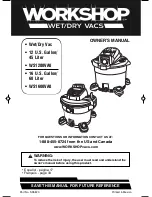
11
1.
Locate blowing port of your Wet/Dry
Vac.
2.
Insert the tabbed end of hose into the
blowing port of the Vac.
3.
(Optional) Attach extension wand to
swivel end of hose, then place a car
nozzle on the wand.
4.
Turn Vac on and you are ready to use
your Vac as a blower.
Dual-Flex
Locking
Hose
Blowing Port
WARNING: To reduce the risk of
back injury or falls, do not lift a Vac
heavy with liquid or debris. Scoop
or drain enough contents out to
make the Vac light enough to lift
comfortably.
Blowing Feature
Your Wet/Dry Vac features “Full Blowing”.
It can blow sawdust and other debris.
Follow the steps below to use your Vac
as a blower.
WARNING: Always wear safety
eyewear complying with ANSI Z87.1
(or in Canada, CSA Z94.3) before
using as a Blower.
CAUTION: Wear a dust mask if
blowing creates dust which might
be inhaled.
CAUTION: To reduce the risk of
hearing damage, wear ear protectors
when using the Vac/Blower for
extended time or in a noisy area.
WARNING: To reduce the risk of
injury to bystanders, keep them
clear of blowing debris.
WARNING: To reduce the risk of
injury from accidental starting,
unplug power cord before emptying
the drum.
Emptying the Drum
1.
The Vac comes equipped with a drain
for easy emptying of liquids. Simply
unscrew the drain cap and lift the
opposite side slightly to empty the
drum.
2.
Another option is to remove the lid.
Pull the flexible latches outward on
each side of the lid to release from the
drum.
3.
While holding the latches out, lift the
top assembly up and away from the
drum.
4.
Lay top assembly upside down on a
clean area while emptying drum or
changing Filter.
5.
Dump the drum contents into the
proper waste disposal container.
!
OPERATION (continued)
!
!
!
!
!
SP6820-1 Workshop 12 16 GALLON:SP6439-3_ES.qxd 8/20/13 9:40 AM Page 11












































